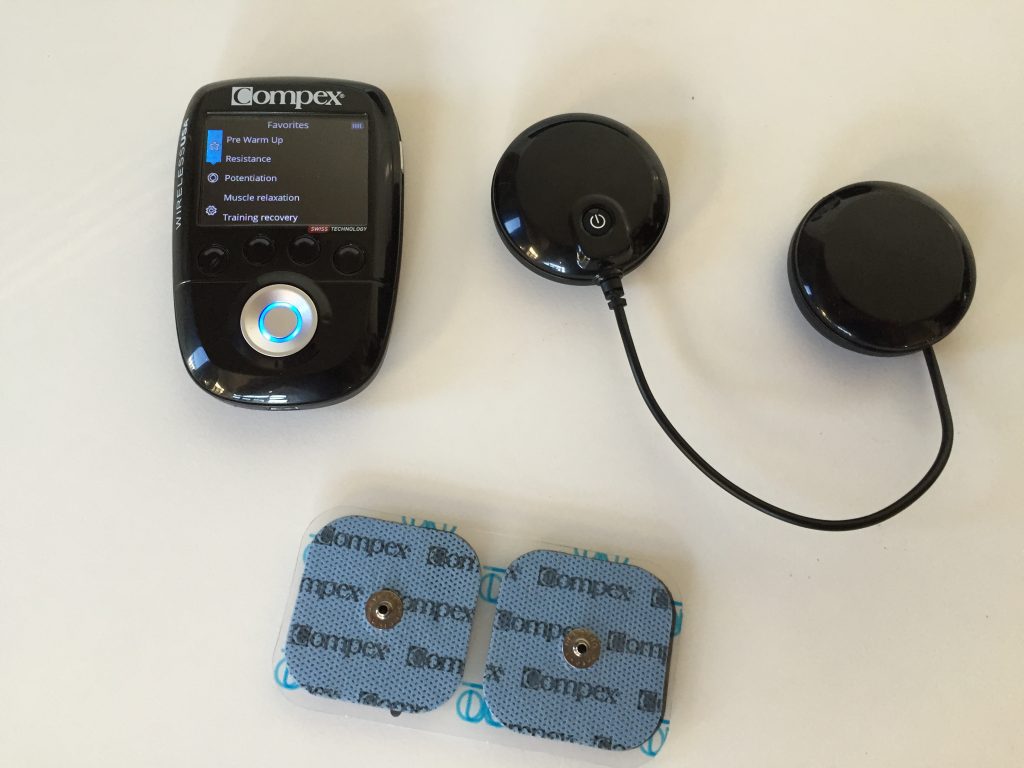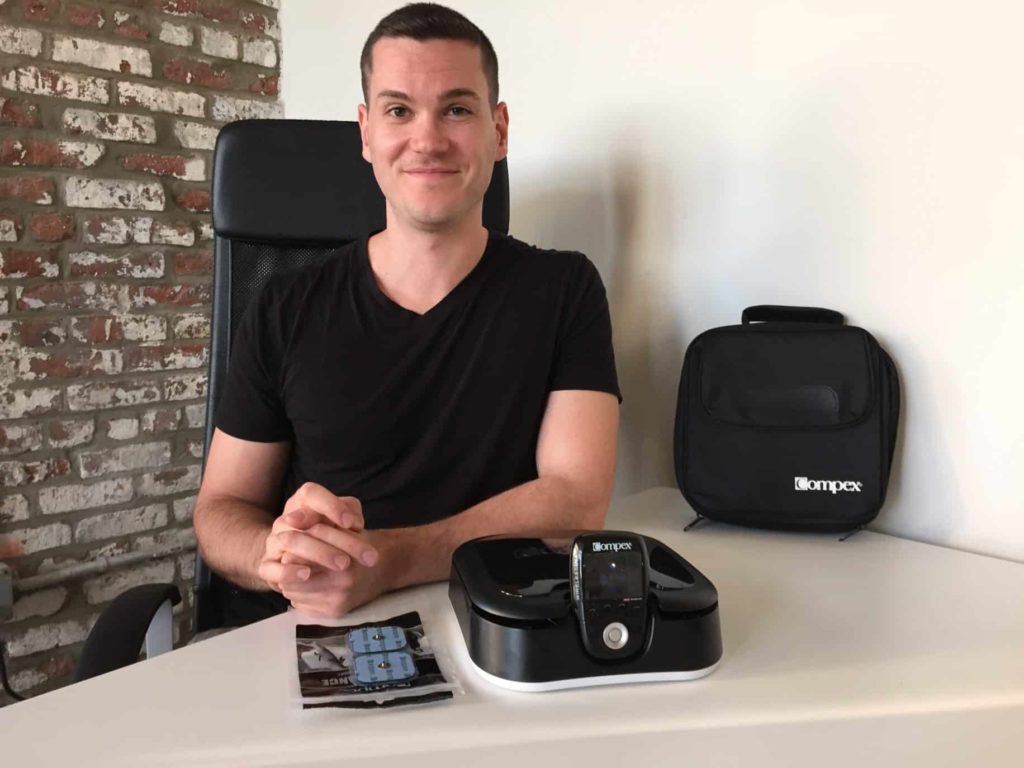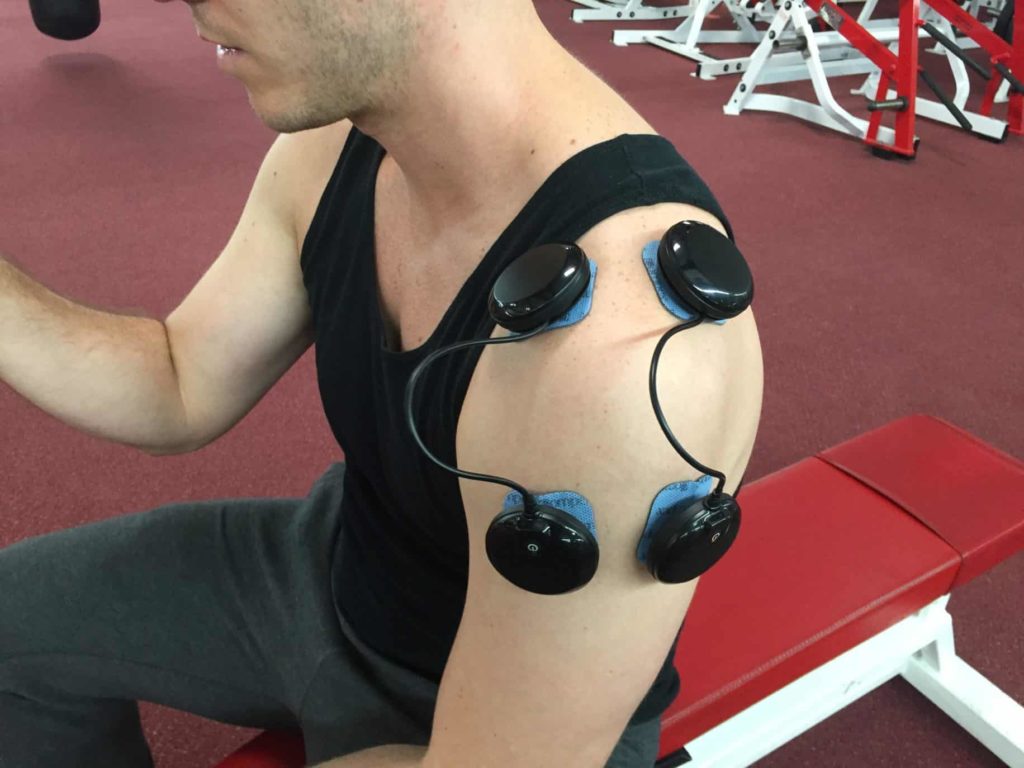Hooking electrodes up to your muscles to improve performance might seem like science fiction, but electronic muscle stimulation, or EMS, is more popular than ever. (Note that it’s a little different than transcutaneous electrical nerve stimulation, or TENS, which focuses more on pain relief.) But which is the best model for your needs? To help you decide, we’re bringing you this Compex Wireless review.
Compex is one of several EMS devices that are available for the average person to experiment with in the gym and at home. The FDA has approved Compex for “increasing your muscle size, strength, and density, boosting VO2 max, honing greater explosive strength, and faster muscle recovery” and the company sponsors many well-known athletes, including the Fittest Man On Earth™ Mat Fraser and Mr. Olympia Phil Heath. We wanted to try out their Compex Wireless device and see what we thought.
Shop Compex Wireless HERE.
What Does Compex Do?
Science has come far enough that EMS devices can do more than just make a muscle jump. Compex’s device has nine separate modes, which are described like this:
- Pre warm-up – prepare for physical activity
- Resistance – to increase recruitment of intermediate fast twitch muscle fibers
- Endurance – to increase the recruitment of slow twitch muscle fibers
- Strength – to increase recruitment of dedicated fast twitch muscle fiber
- Explosive strength – to increase recruitment of dedicated fast twitch muscle fibers and explosive power
- Potentiation – to prepare all 3 muscle fiber types for activity
- Muscle relaxation – relax the muscle
- Training recovery – to recover after a physical effort and “bring fresh oxygen and nutrients to the muscles to facilitate the flushing of toxins”
- Competition recovery – to recover after intense muscle fatigue
You can pick an intensity on a scale from 1 to 100 and generally, Compex likes you to use as much electricity as you can comfortably handle. This helps it to be useful for a wide variety of athletes of different strength and experience levels.

How Do You Use Compex?
We tried out the Compex Wireless, which has modules that you can attach to your body without running the risk of tangling yourself up in wires.
The Compex Wireless comes with eight diodes (four sets of two), and after charging them on the docking station you simply clip them onto adhesive electrodes that you place on your skin.
The product comes with a placement guide that tells you where you can and can’t place them. Over the heart is a no-no, and you’re not meant to place them on the front and back of a body part at the same time, lest electricity jump between the electrodes through your body instead of staying around the muscles.
Note that it’s important to swab your skin with rubbing alcohol or at least to clean it with soap and water before attaching the electrodes to dry skin. This ensures they’ll stay sticky and it increases their longevity — at $15 for a bag of four, electrodes aren’t super cheap.

My Experience Using Compex
The Compex helped me in a lot of ways, but it also had some potential drawbacks.
Some of the features are pretty easy to use and the on-screen instructions on the remote control do a good job of walking you through certain protocols. For example, it’s easy to “pre warm up” and activate your lats, traps, or abs after a long day of sitting. You just attach the electrodes per the booklet, enter the protocol on the remote, and hit “start.” You’ll spend about 20 minutes being zapped, then you can get to exercising.
And again, one of the great things about this product is that it doesn’t have to be plugged into anything, so you can do this warm-up at the gym if you like.
The same can be said for the “relaxation” protocol. It’s easy to set up the diodes so you can sit back and relax while the machine makes your thighs bounce and dance to the electrical current. I like pretty high volume leg workouts and quad soreness is an issue for me. If I hooked myself up to the Compex after getting home, the typical soreness was drastically reduced the following day.

However, it took me a bit longer to figure out some other settings. There are plenty of videos online of athletes actually working out while attached to their Compex, but using the “Resistance” protocol was a bit trickier for me.
When I attached the electrodes and clicked on the Resistance protocol on the remote, I got low level pulses for a few minutes until the screen told me to “Increase intensity up to your maximum” during very intense, seven-second pulses that were followed by seven seconds of rest until the cycle occurred forty-six times.
Why forty-six times? Am I meant to be doing lots of reps or one slow, seven-second rep? Do I need to do all forty-six of these cycles in the same set? Should I pause it after a few reps? At what point in my workout should I do this? Do I do this protocol every workout, or every week, or more or less often? These were some of the questions I had, and it wasn’t super easy to find answers off the bat. I called Compex for some answers, and they informed me that they’ll soon be releasing some video walkthroughs to help users better understand these aspects of the product.

I should also emphasize that the Compex only lets you use the device on one muscle group at a time. For example, let’s say you want to “potentiate” your muscles for a session of squats. You might want to activate your quads, glutes, and perhaps hamstrings to fire up the most active muscles. But each “potentiation” program can only be used on one muscle group and lasts for about 20 minutes each, so stringing multiple sessions together might be too time-consuming.
There are plenty of positives to this product, though. As mentioned, it helped with muscle soreness and activating sleepy muscles, and the Muscle Relaxation and Training Recovery modes can help keep oxygen and blood flowing through your muscles during long periods of sitting. The Pre Warm-Up mode can help your muscles stay engaged during periods of rest — say, when you’re sitting on the bench waiting to be called into a game of basketball or baseball.
I can’t personally speak to the injury recovery benefits, but the studies that suggest it can help are pretty solid.
My main criticism of the product isn’t that it doesn’t work or that it’s overhyped, it’s that it’s sometimes hard to find clear instructions for exactly how to use certain protocols to get desired outcomes. If Compex can produce additional content on the instructional side of their device, I think it could be a real boon to athletes.
Just remember that as is the case with exercise and diet, you shouldn’t expect changes overnight.

Compex Price
Prices are subject to change, but at the time of writing the Compex Wireless costs $800 (though you may be able to find it on Amazon for a bit less). The cheaper, Compex Performance Muscle Stimulator Kit, which is intended for casual gymgoers, costs $280. The Compex Sport Elite Muscle Stimulator Kit, which is intended for competitive athletes, is $390. This is about on par with popular competitors like MarcPro, and while some brands are cheaper, they typically require more wires and offer fewer EMS protocols.
The Takeaway
It’s hard to ignore the considerable data supporting the use of electronic muscle stimulation devices like Compex, and they’ve put out an impressive product. Very few of their competitors are wireless, which makes it way more portable and easy to use. The remote control is simple and easy to use and the diodes last for more than ten hours on one charge, meaning you can even take it on short trips without having to bring the charger.
But don’t guess your way through this high tech electronic muscle stimulation device. Speak to an expert before using it to make sure you’re using it correctly, and you may find that it improves both your recovery and your strength levels.
